Research Article - (2023) Volume 7, Issue 3
Citrus medica Mediated Ag Doped MgO Nanocomposites as Green Adsorbent and Its Catalytic Performance in the Rapid Treatment of Water Contaminants
Sumit Ringwal*,
Aayasha Negi,
Deepak Patel and
Satish C Sati
Department of Chemistry, Garhwal University, Srinagar, Uttarakhand, India
*Correspondence:
Sumit Ringwal, Department of Chemistry, Garhwal University, Srinagar, Uttarakhand,
India,
Email:
Received: 27-Mar-2023, Manuscript No. IPNNR-23-15992;
Editor assigned: 30-Mar-2023, Pre QC No. IPNNR-23-15992 (PQ);
Reviewed: 13-Apr-2023, QC No. IPNNR-23-15992;
Revised: 20-Sep-2023, Manuscript No. IPNNR-23-15992 (R);
Published:
27-Sep-2023, DOI: 10.12769/IPNNR.23.7.021
Abstract
Among various physical and biological methods for the synthesis of the nanocomposite, the green synthesis method is one of the most sustainable approaches for the synthesis of the NCs. Nanomaterials are widely synthesized by using plant extract, which is considered a low cost and highly efficient reactant for the fabrication of nanomaterials. In this research article, Citrus medica peels extract acts as a capping and reducing agent for the synthesis of Ag-MgO NCs. Various characterization techniques were employed for the characterization of fabricated nanomaterial. Like UV-Visible spectroscopy, SEM, EDX, TEM, and TGA. Two different peaks were obtained at different wavelengths in the UV-Visible spectrum for fabricated nanocomposite. The first peak occurred at 346 nm, which corresponds to Ag-NPs, and the second peak was detected at 293 nm, which corresponds to MgO-NPs. X-ray diffraction pattern suggest that the synthesized nanomaterials are cubic in nature. It can be concluded from the TGA plot that the synthesized Ag-MgO nanocomposite is thermally stable up to 600°C. Nanomaterials are uniform and crystalline according to SEM analysis. Fabricated nanomaterial was used as adsorbent for the removal of MB dye which shows significant results about 100% of MB dye was removed when a 4g/L dose of Ag-MgO NCs was used further effect of dose, time and on adsorption was studied. The reduction of MB dye was used to evaluate the catalytic efficiency of the generated nano-catalyst. In this reaction, NaBH4 was used as a reducing agent and nanomaterial as a catalyst. Synthesized NCs exhibit excellent catalytic activity as they degrade toxic dyes up to 90%, 8 min for MB. The rate of reaction was evaluated using a spectrophotometer, and it was reported that the reaction is pseudo-first order and rate constant; we found 8.69 × 10-3s-1. Synthesized NCs can be used as an excellent photo catalyst to degrade various hazardous dyes to improve water quality.
Keywords
Nanocomposite; Photo catalyst; Adsorption study; Citrus medica
Abbreviations
NCs: Nanocomposite; MB: Methylene Blue
Introduction
Water is among the most crucial components for survival on
this planet. Despite water covering around 71% of the earth's
crust, human society continues to suffer an increasing water
shortage. The production of wastewater is expanding
exponentially due to the hasty growth in the human
population and contamination levels. Wastewater
management involves several methodologies, each of which
depends on the contaminant in the wastewater. Industrial
effluent contains inorganic and organic pollutants such as
dyes, phenolic compounds, and toxic metals [1]. Toxic organic
dyes are used significantly in textile, cotton, paints, and
pathological and physiological industries for various
applications [2–4]. Hazardous wastewater from such
enterprises harms human and marine life, which is one of the
scientific community's biggest concerns. One of the most
successful and practical wastewater control approaches is
using catalysts [5].
MgO-based metal oxide nanoparticles are a frequent topic
among researchers, and they have been extensively
investigated in the past due to their versatility. Enhanced
morphology of MgO NPs, silver based MgO nanomaterials
material, or Ag-MgO NCs, has been reported to have
exceptional photocatalytic, antibacterial, anticancer, and antiinflammatory
properties [6–9]. Due to their distinctive optical
and electrical properties and remarkable bioactivities, silver
nanoparticles are one of the most extensively generated
nanostructured materials among noble metals [10-12].
Citrus medica is a Rutaceae family evergreen aromatic tree
with a 4 meter to 5 meter long stem and edible yellowish
orange fruits [13]. The leaves are usually long, shaded, about
10 cm-12 cm long, with a transparent cell. Citrus medica is a
grapefruit that evolved in China and India and has migrated to
Western European countries [14]. Citrus medica is excellent in
vital nutrients, and the fruit peel extract includes many
essential oils. Fruit is a high quality source of vitamins [15].
The essential oil obtained from fruits has antifungal activity
and antioxidant potential [16]. Several medicinal benefits of
the plants have been reported as per literature [17-19]. Ag-
MgO NCs is successfully synthesized in this research
investigation using Citrus medica (Figure 1) peels extract. The
reduction of methylene blue was used to evaluate the
catalytic efficiency of the generated nano-catalyst. In this
reaction, NaBH4 was used as a reducing agent and
nanomaterial as a catalyst. The significance of this
investigation relates to the fact that Ag-MgO NCs from Citrus
medica rind extract and their catalytic efficiency had been not
determined as we had reviewed its literature.
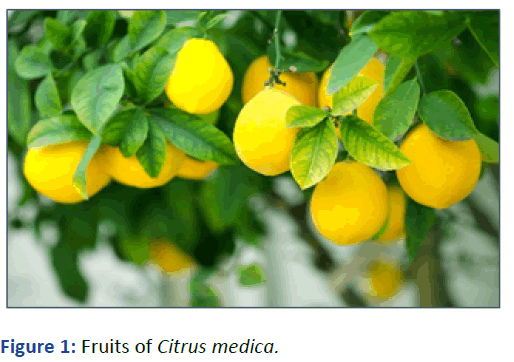
Figure 1: Fruits of Citrus medica.
Materials and Methods
Materials and Procedures
Citrus medica was collected from local gardens of Karokhi
village of Rudraprayag district during mid–November from
Ukhimath, Rudraprayag. Methylene blue chemical formula
(C16H18ClN3S) molecular weight 319.9 g/mol, λmax 664 nm was
secure from HiMedia Laboratories Pvt Ltd. Mg(NO3)2, 6H2O,
AgNO3, and NaOH which were utilized for the synthesis of NCs
were obtained from Sigma-Aldrich. Chemicals were used
directly without any purification. Double distilled water was
utilized during the biosynthesis and dilution procedures.
Preparation of Peels Extract
For 15 days, the fresh peels of Citrus medica were shed dried,
initially fresh peels was washed with double distil water to
remove impurities, then dried peels were crushed into
powdered form using hand grinder. About 10 g of powdered
peels were added into 250 ml of distil water and resultant
mixture was heated at 60 for 30 min. filtration was done with
the help of Whattman no 01 filter paper and filtrate were
kept for further experiments [20].
Role of Plant Extract
Alkaloids, flavonoids, steroids, phenols, and carbohydrates are
secondary metabolites isolated from peels of Citrus medica.
While major constituents isolated from peels are isolimonene
39.37%, citral 23.12%, limonene 21.78%, β-Mycene 2.70%
neryl acetate 2.51% and neryl alcohol 2.25%. Different parts of
plants have been extensively used in the green synthesis of
nanomaterial due to the presence of various secondary
metabolites like steroids, sapogenins, tannins, terpenoids,
polyols, alkaloids, polysaccharides, flavonoids, phenolics,
proteins, amino acids, enzymes, and vitamins. They act as
chelating, reducing and stabilizing agents, which prevent
agglomeration, uncontrol growth and provide stability to
nanomaterial. Secondary metabolites Steroids, phenols,
alkaloids and carbohydrates present in plant extract act as
reducing and capping agents.
Preparation of Ag-Mgo Nanocomposite
Initially fresh 5 mM solution of AgNO3 was prepared along
with 0.1 M Mg (NO3)2.6H2O solution and 0.1 M NaOH solution
were prepared to synthesize Ag-MgO NCs. Afterwards,
prepared plant extract and AgNO3 solutions were added in
fixed ration (2:3 v/v %). 80 mL of this resultant solution (plant
extract and AgNO3) was added to 20 mL of 0.1M Mg(NO3)2.
6H2O solution, which was stirred continuously for 2 hours.
Furthermore, further 2 mL prepared NaOH solution was
applied until complete precipitation was achieved. The
reaction mixture was centrifuged for 10 minutes at 16000 rpm
in a laboratory centrifuge.
Preparation of Stock Solution of Methylene Blue Dye
Methylene Blue dye (MB) of 1000 mg/L quantity stock
solution was made ready by mixing precisely weighted 1 gm
of MB in 1 L distilled water. The solution was further diluted
as per the prerequisite.
Characterization Techniques
The synthesized Ag-MgO NCs was confirmed by utilizing
various spectroscopic and microscopic techniques like TEM
(Transmission Electron Microscopy), UV-Vis spectroscopy, and
XRD (X-Ray Diffraction), SEM (Scanning Electron Microscopy)
and TGA (Thermo Gravimetric Analysis). TEM was performed
at JEM-1400 Transmission Electron Microscope (TEM) features
high resolution/high contrast imaging. It has a maximum
accelerating voltage of 120 KV, a ± 70 degrees tilted computercontrolled
stage. UV-Visible spectra of the synthesized
materials were recorded by Hitachi U-2900 double beam
spectrophotometer, XRD was performed by Philips powder
diffractometer type PW 1373 goniometer (Cu Ka=1.5406) at a
scanning rate of 6/min in the 2ϴ range of 10 to 80 and SEMEDAX
analysis of the prepared sample was performed on the
model CRAL ZEISS, model No. MA15/EVO18, Oxford
instruments x-act (EDAX).
Adsorption Study
Batch method was applied for the estimation of sorption trials
in this process 10 mL of MB sample and fixed sorbent dose
was mechanically agitating 100 mL Erlenmeyer flasks. The
blend was agitated at 210 rpm for 0 to 120 min at pH 7 and
ambient temperature conditions. UV-Visible spectroscopy was
utilized to calculate the optimum supernatant quantity
(sample) by measuring absorbance at 664 nm. The graph was
plotted between absorbance and amount of MB solution gave
initial quantity of MB solution, from initial and equilibrium
concentration of dye % removal of dye can be easily
calculated using the formula.
Qe= (Co–Ce) V/m
Where,
• Co=Initial dye quantity.
• Ce=Quantity at equilibrium.
• V(L)=Voluminous level of the liquid solvent.
• m(g)=Sorbent quantity
All experiments were performed in triplet and the average
value of Ce and Qe was taken for further experiments. The
amount of sorbent pH, time, and were studied. Sorption
quantity was calculated by the help of formula mentioned in
the literature.
Catalytic Properties of Ag-Mgo NCs
The reduced hazardous dye was used to evaluate the catalytic
efficiency of the generated nano-catalyst Methylene Blue
(MB); UV-Visible spectroscopy was used to assess the
reaction's progress. In summary, 1 mm dye solution was
mixed with the newly prepared 0.5 M NaBH4 solution and
fabricated NCs. Furthermore, this reaction mixture was kept
in a cuvette of 4 ml volume and 1 cm path length.
Results and Discussion
UV-Visible Spectroscopy
A peak at 440 nm was obtained in the UV-Visible spectra of
previously synthesized Ag-NPs. Two different peaks were
obtained at different wavelengths in the UV-Visible spectra of
the fabricated NCs. (Figures 2 and 3). The first peak occurs at
346 nm, which corresponds to Ag-NPs, and the second peak
was noticed at 293 nm, which corresponds to MgO-NPs.
Those two different peaks reveal the formation of belayed Ag-
MgO NCs [21].
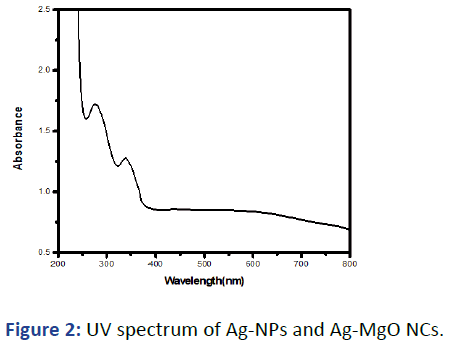
Figure 2: UV spectrum of Ag-NPs and Ag-MgO NCs.
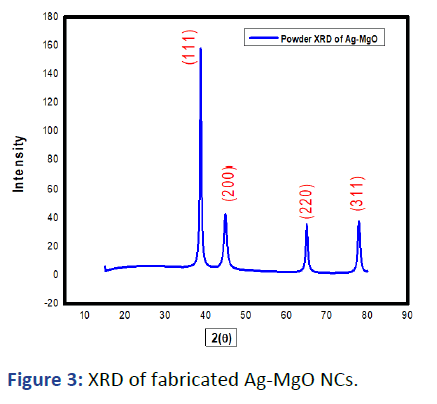
Figure 3: XRD of fabricated Ag-MgO NCs.
XRD Spectroscopy
Peaks obtained in the X-ray diffraction pattern of
fabricated Ag-MgO NCs' are illustrated in Figure 3.
Synthesized Ag-MgO NCs show a peak at (h,k,l) values
indexed to (111), (200), (220), (311), and (312), respectively
(222) and d spacing value are 2.38, 2.06, 1.45, 1.23 and
1.19 respectively, thus confirming the composite nature
of the material with a cubical crystal lattice network. The
Scherrer’s equation was used to compute the average
crystalline size of the synthesized Ag-MgO NCs, and the
average crystalline size was found to be 16.43 nm [6].
SEM Analysis
In Figure 4, SEM photographs of synthesized nanomaterial are
shown. This image depicts a multilayer assembled particle
buildup. In nature, fabricated particles are non-uniform and
crystalline. This aggregation could be due to heterocyclic
chemicals in plant material.
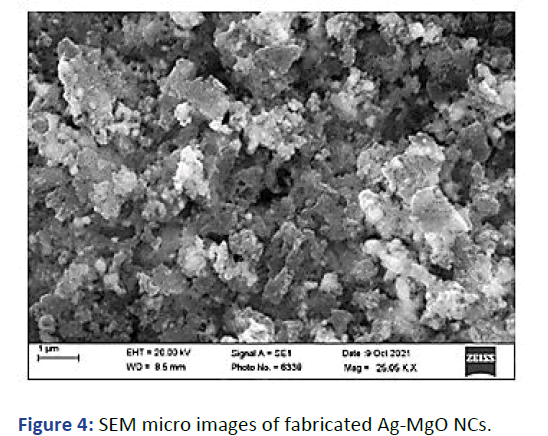
Figure 4: SEM micro images of fabricated Ag-MgO NCs.
SEM-EDX Analysis
The EDX study, illustrated in Figure 5, determines the
basic structure of fabricated NCs. The occurrence of 58.19
percent oxygen, 35.91 percent silver, and 58.91 percent
magnesium as major components is revealed by EDX results.
SEM-EDX study discloses that the manufactured nanomaterial
mainly comprises silver, oxygen, and magnesium.
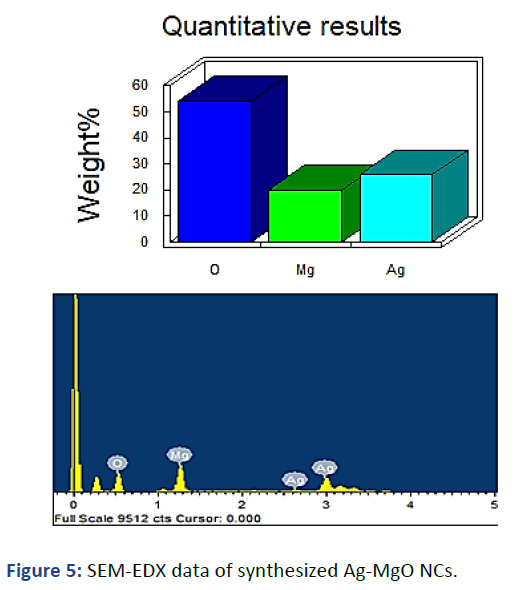
Figure 5: SEM-EDX data of synthesized Ag-MgO NCs.
TEM Study
TEM micro images suggest that most of the particles are
spherical and very few particles are agglomerated (Figure 6).
Since most of the particles are spherical then it can be
concluded that synthesized nanomaterials are quite stable.
The average grain size was estimated at around 24.93 nm.
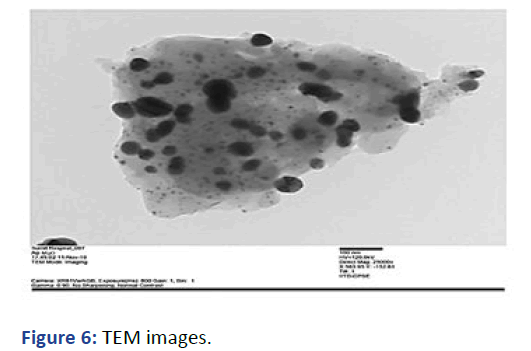
Figure 6: TEM images.
Thermal Gravity Analysis (TGA)
Thermal gravity analysis results are shown in Figure 7 results
shows that Ag-MgO NCs remains almost stable until
temperature reach 300°C around 10% of weight lose until
300°C this weight loss may be attributed due to lose of
moisture in sample. Significant weight loss of 45% was
observed when temperature reach up to 400°C and it may be
due to decomposition of major chemical in the composition
of Ag-MgO NCs. It can be concluded from TGA plot that the
synthesized Ag-MgO NCs is thermally stable up to 600°C.
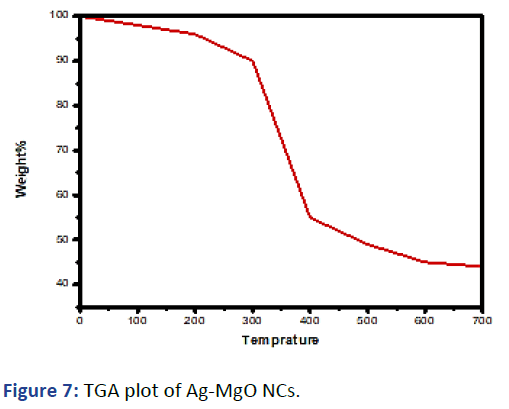
Figure 7: TGA plot of Ag-MgO NCs.
Band Gap Plot
Tauc equation was used to estimate the band gap of
synthesized Ag-MgO NCs, in which UV-Visible data was
exploited to plot the graph between (αhʋ)2 and (αhʋ)1/2
against hʋ, where ‘α’ is the absorbance of photon energy, ‘h’ is
Planck's constant, ‘υ’ is frequency, ‘Eg’ is optical energy band
gap and ‘n’ is a constant represented the different types of
electronic transitions. The obtained band gap is shown in Figure 8 shown below. Band gap was estimated as 3.49 eV.
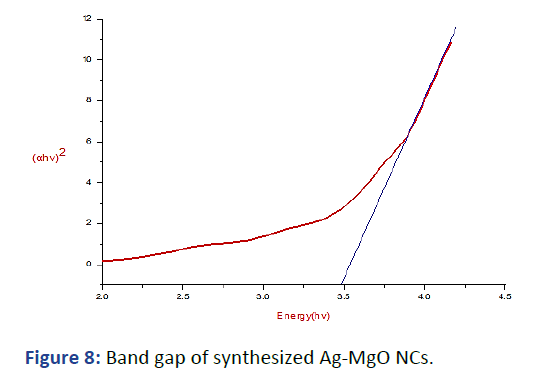
Figure 8: Band gap of synthesized Ag-MgO NCs.
Absorption Analysis
In luence of bio-sorbent dosage: Six doses of different
amount ranging from 1 g/L-4 g/L were taken for the
investigation of effect of Ag-MgO dose on adsorption
efficiency. Results show that MB dye show greater adsorption
with increase of Ag-MgO dose. At lowest dose of 1 g/L of Ag-
MgO MB dye shows adsorption efficiency of 85% while
maximum adsorption efficiency 100% was archived when
highest dose of 4 g/L of Ag-MgO was used. It was observed
that when medium adsorbent dose 2 g/L was used about 95%
of MB was removed from the aqueous solution. That is why it
was used for further studies.
In luence of time: The batch mode of analysis was performed
to calculate equilibrium time for optimum treatment efficacy
and to estimate the sorption kinetics, in which 10 mg/L of MB dye was studied at 20 min time duration ranging from 20
min-120 min with 2 g/L of Ag-MgO NCs dose. The graph was
plotted between treatment efficiency and time of contact,
and it was observed that the 70% of MB dye was removed in
just 20 min and it reached state of equilibrium at 100 min,
when removal efficiency was estimated 95%. Such
observation may be due to fact that at initial period larger
multitudes of empty active site was reachable over Ag-MgO
NCs. Periphery for MB molecule, but after certain period
surface get partially unavailable and reachable, so active site
for Ag-MgO NCs. Decreases so MB molecules change their
path to obtain reachable and unoccupied active site.
In luence of solution pH: The adsorption efficiency of MB
sample is greatly affected by pH of the MB solution, because
pH affects the sorbent periphery charge and the degree of
ionization of MB molecule which also affect the adsorption
efficacy of Ag-MgO NCs., which shows different result at
various pHs. It was observed that Ag-MgO acquire positive
charge on its surface due to protonation and negative charge
on its surface due to deprotonation in basic medium. While
MB exist in anionic form in aqueous medium at higher pH,
less adsorption was observed when negatively energized Ag-
MgO NCs. approaches toward negatively charged MB they get
repulsion from each are. However, attraction was observed
when positively charged Ag-MgO NCs approach toward
negatively charged MB molecule at lower pH (Figure 9).
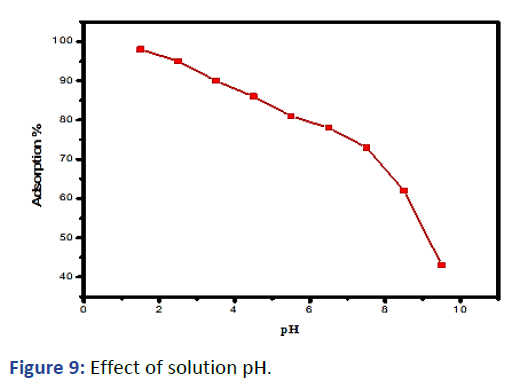
Figure 9: Effect of solution pH.
Catalytic Performance of Ag-MgO NCs for Deterioration
MB
Methylene blue is a hazardous dye which displays λmax at 664
nm in the UV spectra. When the dye is added to a mixture of
NCs and NaBH4, the absorbance value decreases rapidly with
time, UV-Visible spectra results reveal that the MB degrade
91% in 8 min in the presence of the reaction mixture. The rate
of reaction was evaluated using a spectrophotometer, and it
was reported that the rate is independent of the
concentration of Sodium borohydride. This implies that the
reaction is pseudo first order (Figure 10). When we plotted
the graph between ln (At/A0) and the radiation time rate
constant was found 8.69 ×10-3s-1 for Ag-MgO NCs.
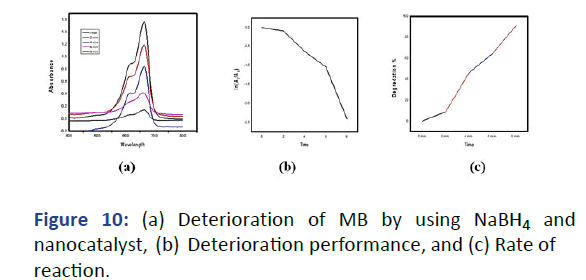
Figure 10: (a) Deterioration of MB by using NaBH4 and
nanocatalyst, (b) Deterioration performance, and (c) Rate of
reaction.
Conclusion
In this research article, Ag-MgO NCs were effectively
fabricated using Citrus medica rinds extract as capping and a
reducing agent. Various characterization techniques were
employed for the characterization of fabricated Ag-MgO
nano-material. Two prominent peaks were obtained in the
UV-Visible spectrum of the fabricated NCs, which is a clear
indication of the synthesis of the NCs. X-ray diffraction pattern
results indicate the cubic nature of synthesized NCs. The
mean grain size was estimated to be 16.43 nm. It can be
concluded from TGA plot that the synthesized Ag-MgO NCs is
thermally stable up to 600°C. According to the SEM study,
fabricated nano-materials were found to be poly dispersive
and crystalline. Fabricated nanomaterial was used as
adsorbent for removal of MB dye which shows significant
results about 100% of MB dye was removed when 4g/L dose
of Ag-MgO NCs was used further effect of dose, time and pH
on adsorption was studied. The reduction of MB dye was used
to evaluate the catalytic efficiency of the generated nanocatalyst.
In this reaction, scream NaBH4 was used as a
reducing agent and nanomaterial as a catalyst. Synthesized
NCs exhibit excellent catalytic activity as they degrade toxic
dyes up to 90%, 8 min for MB. The rate of reaction was
evaluated using a spectrophotometer, and it was reported
that the reaction is pseudo first order and rate constant; we
found 8.69 × 10-3s-1. Synthesized NCs can be used as an
excellent photo catalyst to degrade various hazardous dyes to
improve water quality.
Acknowledgement
For characterization of synthesized NCs, the authors are
obliged to the department of University Science
Instrumentation Centre (USIC), H.N.B. Garhwal university. This
work is not sponsored by any funding agencies.
Declaration of Interest Statement
I, Dr. Sumit (research scholar department of chemistry), on
the behalf of all entitle authors, declare that the submitted
manuscript is original and has not been or is not being
submitted to any other journal., and we have not received any
grant from funding agency. Hope you will consider it as soon
as possible. We are looking forward for your kind
consideration.
References
- Pathania D, Gupta D, Al-Muhtaseb AH, Sharma G, Kumar A, et al. (2016) Photocatalytic degradation of highly toxic dyes using chitosan-g-poly(acrylamide)/ZnS in presence of solar irradiation. J Photochem Photobiol. 329:1-68.
[Crossref] [Google Scholar]
- Nasrollahzadeh M, Sajjadi M, Dadashi J, Ghafuri H (2020) Pd based nanoparticles: Plant assisted biosynthesis, characterization, mechanism, stability, catalytic and antimicrobial activities. Adv Colloid Interface Sci. 276.
[Crossref] [Google Scholar] [PubMed]
- Nasrollahzadeh M, Mahmoudi GYS, Motahharifar N, GhaforiGorab M (2019) Recent developments in the plant mediated green synthesis of Ag based nanoparticles for environmental and catalytic applications. Chem Rec. 19(12):2436-2479.
[Crossref] [Google Scholar] [PubMed]
- Nasrollahzadeh M, Sajadi SM (2016) Green synthesis of Pd nanoparticles mediated by Euphorbia thymifolia L. leaf extract: Catalytic activity for cyanation of aryl iodides under ligand free conditions. J Colloid Interface Sci. 469:191-195.
[Crossref] [Google Scholar] [PubMed]
- Nasrollahzadeh M, Issaabadi Z, Sajadi SM (2018) Green synthesis of Pd/Fe3O4 nanocomposite using Hibiscus tiliaceus L. extract and its application for reductive catalysis of Cr (VI) and nitro compounds. Sep Purif Technol. 197:253-260.
[Crossref] [Google Scholar]
- Pakzad K, Alinezhad H, Nasrollahzadeh M (2019) Green synthesis of Ni@ Fe3O4 and CuO nanoparticles using Euphorbia maculata extract as photocatalysts for the degradation of organic pollutants under UV-irradiation. Ceram Int. 45(14):17173-17182.
[Crossref] [Google Scholar]
- Nasrollahzadeh M, Sajjadi M, Dasmeh HR, Sajadi SM (2018) Green synthesis of the Cu/sodium borosilicate nanocomposite and investigation of its catalytic activity. J Alloys Compd. 763:1024-1034.
[Crossref] [Google Scholar]
- Nasrollahzadeh M, Sajjadi M, Sajadi SM (2018) Biosynthesis of copper nanoparticles supported on manganese dioxide nanoparticles using Centella asiatica L. leaf extract for the efficient catalytic reduction of organic dyes and nitroarenes. Chinese J Catal. 39(1):109-117.
[Crossref] [Google Scholar]
- Nasrollahzadeh M, Issaabadi Z, Sajadi SM (2018) Green synthesis of a Cu/MgO nanocomposite by Cassytha filiformis L. extract and investigation of its catalytic activity in the reduction of methylene blue, congo red and nitro compounds in aqueous media. RSC advances. 8(7):3723-3735.
[Crossref] [Google Scholar] [PubMed]
- Nasrollahzadeh M, Akbari R, Issaabadi Z, Sajadi SM (2020) Biosynthesis and characterization of Ag/MgO nanocomposite and its catalytic performance in the rapid treatment of environmental contaminants. Ceram Int. 46(2):2093-2101.
[Crossref] [Google Scholar]
- Zhang L, Wang L, Zhang Y, Wang D, Guo J, et al. (2022) The performance of electrode ultrafiltration membrane bioreactor in treating cosmetics wastewater and its anti-fouling properties. Environ Res. 206.
[Crossref] [Google Scholar] [PubMed]
- Guan Q, Zeng G, Song J, Liu C, Wang Z, et al. (2021) Ultrasonic power combined with seed materials for recovery of phosphorus from swine wastewater via struvite crystallization process. J Environ Manage. 293.
[Crossref] [Google Scholar] [PubMed]
- Chhikara N, Kour R, Jaglan S, Gupta P, Gat Y, et al. (2018) Citrus medica nutritional, phytochemical composition and health benefits–a review. Food Funct. 9(4):1978-1992.
[Crossref] [Google Scholar] [PubMed]
- Al-Yahya MA, Mothana RA, Al-Said MS, El-Tahir KE, Al-Sohaibani M, et al. (2013) Citrus medica “Otroj”: Attenuates oxidative stress and cardiac dysrhythmia in isoproterenol induced cardiomyopathy in rats. Nutrients. 5(11):4269-4283.
[Crossref] [Google Scholar] [PubMed]
- Mukherjee PK, Wahile A (2006) Integrated approaches towards drug development from Ayurveda and other Indian system of medicines. J Ethnopharmacol. 103(1):25-35.
- Ringwal S, Bartwal AS, Nautiyal SC, Sati SC (2021) Evaluation of antioxidant activity of synthesized silver nanoparticles from Citrus aurantium peels extract by using the green method. J Mountain Res. 16(2):191-198.
[Crossref] [Google Scholar]
- Bartwal AS, Sumit SSC (2020) Biosynthesis of silver nanoparticles from flowers of Rhododendron campanulatum tree of Tungnath Himalaya. Appl Innov Res. 2(1):39-43.
[Google Scholar]
- Sati SC, Sumit, Bartwal AS, Alok KA (2020) Green synthesis of silver nanoparticles from Citrus medica peels and determination of its antioxidant activity. Appl Innov Res. 2(1):56-60.
[Google Scholar]
- Sati SC, Kour G, Bartwal AS, Sati MD (2020) Biosynthesis of metal nanoparticles from leaves of Ficus palmata and evaluation of their anti-inflammatory and anti-diabetic activities. Biochemistry. 59(33):3019-3025.
[Crossref] [Google Scholar] [PubMed]
- Kaur G, Tripathi PK, Sati SC, Mir MA (2018) Synthesis of silver nanoparticles using leaves extract: Characterization Ficus palmata and evaluation for its antimicrobial and antioxidant activities. Asian J Pharm Pharmacol. 4(2):192-198.
[Crossref] [Google Scholar]
- Bartwal AS, Ringwal S, Sati SC (2021) Antimicrobial activity of AgNPs synthesized via green approach by using flowers of Bistorta macrophylla herb of Tungnath Himalaya Region. J Mount Res. 16(1):161-167.
[Crossref] [Google Scholar]
Citation: Ringwal S, Negi A, Patel D, Sati SC (2023) Citrus medica Mediated Ag Doped MgO Nanocomposites as Green Adsorbent and Its Catalytic Performance in the Rapid Treatment of Water Contaminants. J Nanosci Nanotechnol Res. 7:021.
Copyright: © 2023 Ringwal S, et al. This is an open-access article distributed under the terms of the Creative Commons Attribution License, which permits unrestricted use, distribution, and reproduction in any medium, provided the original author and source are credited.











